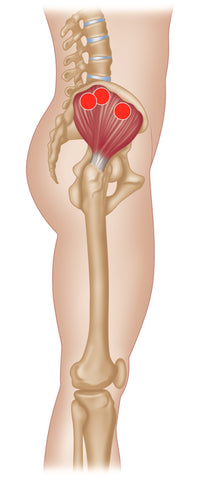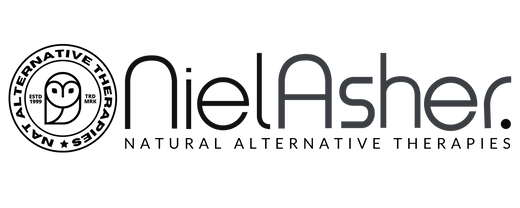Trigger Point Therapy - Gmed Causing MCL Pain and Meniscal Pain
Treating Trigger Points - Gluteus Medius (GMed)
How can a weakness of the glutes be responsible for knee pain?
There are a number of factors regarding the Gmed that need to be taken into account when we are looking at medial or lateral knee pain.
“Medial knee drift,” which is a valgus position of the tibiofemoral joint and, less common, “lateral knee drift” which is a varus position of the tibiofemoral joint.
When a client consults their therapist with knee pain, they might have been told that one of the causes of their knee pain is a weakness found in the Gmax or Gmed.
So how can a weakness of the glutes be responsible for knee pain?
The Gmed posterior fibers assist the Gmax in controlling the alignment of the hip through the knee to the foot during the gait cycle.
If for some reason the Gmed posterior fibers are weak (trigger points is one common reason), the knee can drift medially when walking or running.

The knee joint, showing the meniscus and the MCL
Antagonists
Which muscle is antagonistic to the Gmed? The answer is the adductors, and if there is an underlying factor that causes the adductors to become tight and shortened (again, trigger points may come into play here), this might in turn be a causative factor for weakness of the Gmed posterior fibers.
If the adductors are short, they are generally in a hypertonic state. In this case, when we contact the ground during the gait cycle, the main stabilizing muscle of the lateral sling should be the Gmed, as this also keeps the alignment of the pelvis.

Gluteus Medius (GMed) - Trigger points make the host muscle shorter, weaker, and less efficient. This can trigger, or be part of, a chain of events that can cause MCL and Meniscal pain.
Dangerous Pattern of Compensation
If the adductors receive more neural stimulus from the obturator nerve (as when the adductors have become the main stabilizing muscle instead of the Gmed). This compensation pattern will naturally take the hip into an increased medial rotation, adduction, and hip flexion.
As a result, the knee drifts medially (valgus position) because of the increased medial rotation of the femur caused by the hypertonic adductors and the weakened Gmed.
As this compensation pattern continues it can be precursory to loading of the MCL and the underlying attachment to the medial meniscus because of the altered biomechanics.
Moreover, the lateral meniscus can also be involved owing to a compressive force caused by the increased valgus position of the knee.
Lateral Knee Drift
Because of the varus position, lateral knee drift is rarely seen in the sports injury clinic. There is limited information in the literature about this condition and many therapists may not be aware of it.
Lateral knee drift can be observed in a patient performing a single-leg squat if they have a weakness in their Gmed or Gmax.
It can also occur when an athlete is running and they have an anterior-tilted pelvis with a forward trunk position.
At heel-strike the knee can be forced into a lateral shift so that the Gmed is offloaded and the foot/ankle is forced into a more supinated position.
This excessive lateral drift of the knee will place increased strain on the medial meniscus because of the increased compression of the varus position.
It can also overload the ITB and the popliteus muscle.
Case Studies
My Journey with NAT - Stuart Hinds (Soft Tissue Therapist)
My Journey with NAT - Michael Coffee (Licensed Massage Therapist)
My Journey with NAT - Suzanne Hibberd (Osteopath)
My Journey with NAT - Martin Bates (Chiropractor)
My Journey with NAT - Andy Eckley (Soft Tissue Therapist)
Links
Find a Trigger Point Professional in your area
More Articles About Frozen Shoulder
More Articles About the Rotator Cuff
Dry Needling for Trigger Points
Certify as a Trigger Point Therapist
About NAT Courses
As a manual therapist or exercise professional, there is only one way to expand your business - education!
Learning more skills increases the services that you offer and provides more opportunity for specialization.
Every NAT course is designed to build on what you already know, to empower you to treat more clients and grow your practice, with a minimal investment in time and money.
Help Desk
About Niel Asher Education
Niel Asher Education is a leading provider of distance learning and continued education courses.
Established in the United Kingdom in 1999, we provide course and distance learning material for therapists and other healthcare professionals in over 40 countries.
Our courses are accredited by over 90 professional associations and national accreditation institutions including the National Academy of Sports Medicine (NASM) and National Certification Board for Therapeutic Massage and Bodywork (NCBTMB). Full details of all international course accreditations can be found on our website.
Printed course materials and other products offered on our websites are despatched worldwide from our 3 locations in the UK (London), USA (Pennsylvania) and Australia (Melbourne).
More About Us
NAMTPT AWARD 2017
We are honored to have received the 2017 "Excellence in Education" Award from the National Association of Myofascial Trigger Point Therapists.
Since 1999 Niel Asher Education has won numerous awards for education and in particular for education and services provided in the field of trigger point therapy.
Read Full Article
Award Winning Instructors
Niel Asher Healthcare course instructors have won a host of prestigious awards including 2 lifetime achievement honorees - Stuart Hinds, Lifetime Achievement Honoree, AAMT, 2015, and Dr. Jonathan Kuttner, MD, Lifetime Achievement Honoree, NAMTPT 2014.
Meet the Instructors
NAT Certification
If you are a qualified/licensed manual therapist or exercise/fitness professional you can expand your credentials with NAT certification.
In addition to national accreditation for continued education, each course that we offer includes "NAT Learning Credits". By taking and completing courses you can accumulate NAT credits to qualify for NAT certification.
There are currently 3 levels of NAT certification. Certifying NAT is a valuable way to show your clients that you take continued education seriously, and to promote your skills and qualifications.
About NAT Certification
Niel Asher Technique
Since 1999 the Niel Asher Technique for treating trigger points has been adopted by over 100,000 therapists worldwide, and has been applied to the treatment of a number of common musculoskeletal injuries.
The Niel Asher Technique for treating frozen shoulder was first introduced and published in 1997 and has been widely adopted by therapists and exercise professionals working within elite sports and athletics.
Read More
Worldwide Free Shipping
Most of our courses are available as either "Printed" or 'Download" editions. When you purchase a download edition, you receive immediate lifetime access to all course material. Course texts can be downloaded and printed if required.
When you purchase a "Printed" edition, you will also receive free access to the download edition.
We ship Worldwide from locations in the USA, UK, and Australia. Most items are despatched within 24 hours and shipping is FREE for all orders over US$50.
Shipping
This trigger point therapy blog is intended to be used for information purposes only and is not intended to be used for medical diagnosis or treatment or to substitute for a medical diagnosis and/or treatment rendered or prescribed by a physician or competent healthcare professional. This information is designed as educational material, but should not be taken as a recommendation for treatment of any particular person or patient. Always consult your physician if you think you need treatment or if you feel unwell.

Ready to take your practice to the next level?
Explore which continuing education course is right for you.















